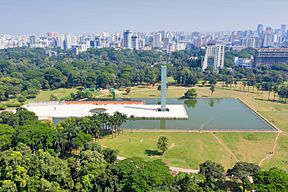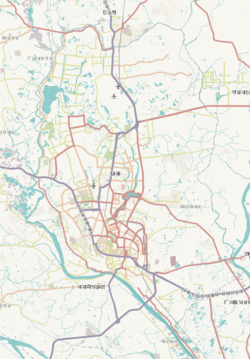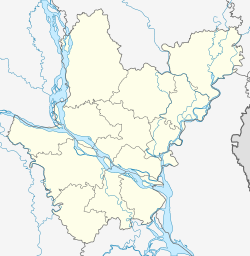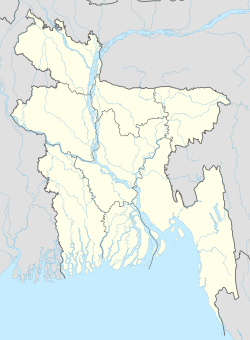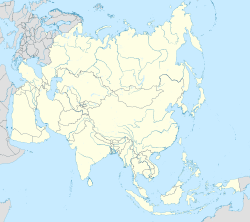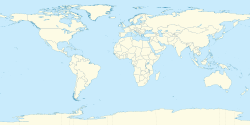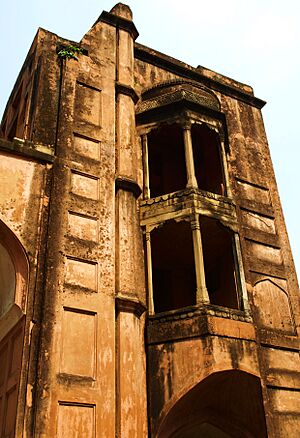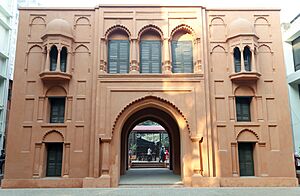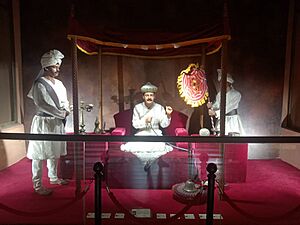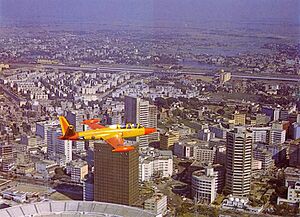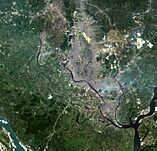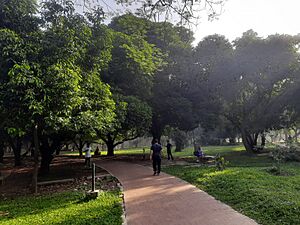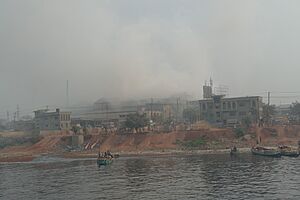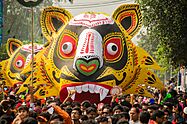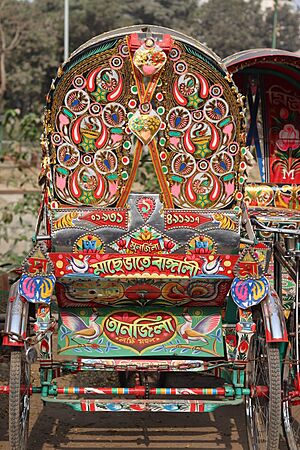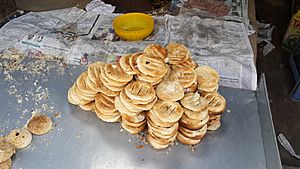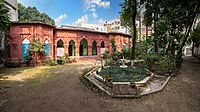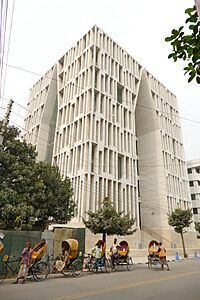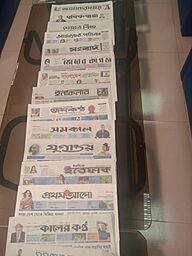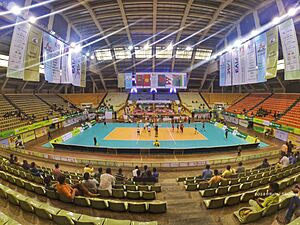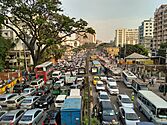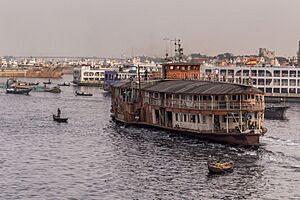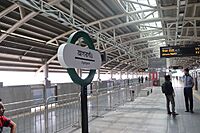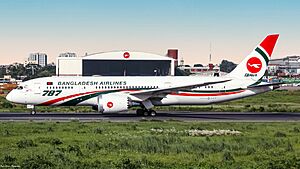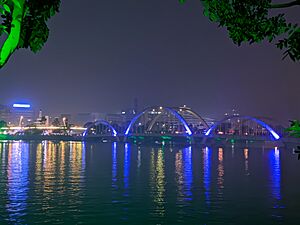Dhaka facts for kids
Quick facts for kids
Dhaka
ঢাকা
Dacca
|
|
|---|---|
|
Skyline of Motijheel Commercial Area
Ahsan Manzil in Old Dhaka
Lalbagh Fort
Curzon Hall of the University of Dhaka
Independence Monument in Suhrawardy Udyan
|
|
| Nicknames:
The Venice of the East,
City of Mosques, City of Rickshaws, City That Never Sleeps |
|
| Country | Bangladesh |
| Division | Dhaka Division |
| District | Dhaka District |
| Establishment | 1608 |
| Government | |
| • Type | Mayor–council |
| • Body | DNCC and DSCC |
| Area | |
| • Megacity | 270 km2 (100 sq mi) |
| • Metro | 1,600 km2 (618 sq mi) |
| Elevation | 32 m (104.96 ft) |
| Population
(2022)
|
|
| • Megacity | 10,278,882 |
| • Density | 38,100/km2 (98,600/sq mi) |
| • Metro | 23,935,652 |
| • Metro density | 15,000/km2 (38,731/sq mi) |
| • City rank | 1st in Bangladesh |
| • Metro rank | 1st in Bangladesh; 1st in Bengal Region; 3rd in South Asia; 9th in Asia; 9th in the world |
| Demonym(s) | Dhakaiya, Dhakaites |
| Languages | |
| • Official | Bengali • English |
| Time zone | UTC+06:00 (BST) |
| Postal code |
1000, 1100, 12xx, 13xx
|
| National calling code | +088 |
| Vehicle registration | DHAKA-D-11-9999""111 |
| HDI (2021) | 0.745 high · 1st of 20 |
| Calling code | +880-2 (for Dhaka City only) |
| Police | Dhaka Metropolitan Police |
| International airport | Hazrat Shahjalal International Airport |
| Rapid Transit | Dhaka Metro Rail |
| Metropolitan Planning Authority | Rajdhani Unnayan Kartripakkha |
| Water Supply and Sewerage Authority | Dhaka WASA |
| UN/LOCODE | BD DAC |
| Website | (North Dhaka) (South Dhaka) |
Dhaka (/ˈdɑːkə/ DAH-kə or /ˈdækə/ DAK-ə; Bengali: ঢাকা, romanized: Ḍhākā, pronounced [ˈɖʱaka]), once known as Dacca, is the capital and largest city of Bangladesh. It is one of the biggest and most crowded cities in the world. Dhaka is a megacity, meaning it's a very large city with millions of people. As of 2024, about 10.2 million people live in the city itself, and over 23.9 million live in the wider Dhaka Metropolitan Area.
Dhaka is a very important place for culture, business, and science in Eastern South Asia. It's also a major city with a large Muslim population. The city's economy is strong, ranking third in South Asia for its total economic output. Dhaka is located on the Ganges Delta, surrounded by rivers like the Buriganga and Turag. It is also the largest city where people speak Bengali.
The area where Dhaka stands has been lived in for over a thousand years. A modern city began to grow in the 1600s when it became a capital and trading center for the Mughal Empire. For 75 years, Dhaka was the capital of Mughal Bengal, a time when it was known for its muslin trade in Bengal and was one of the richest cities globally. The Mughals called it Jahangirnagar, after Emperor Jahangir. Rich merchants from all over Eurasia came to Dhaka. It was even called the Venice of the East because of its many waterways.
When the British took over, Dhaka saw new things like electricity, railways, and modern universities. It became an important center for education and government. After British rule ended in 1947, Dhaka became the capital of East Pakistan. Then, in 1971, after the Liberation War, it became the capital of independent Bangladesh. In 2008, Dhaka celebrated 400 years as a city.
Today, Dhaka is a beta-global city, meaning it's a key city that connects its region to the world economy. It's where the Government of Bangladesh is located, along with many big companies and important educational and research groups. The city has grown a lot, with more people, more land, and more different kinds of businesses. It's now one of the most industrial areas in Bangladesh. Dhaka's culture is famous for its rickshaws, delicious Kachi Biryani, art festivals, and street food. Its most famous building is the Jatiyo Sangshad Bhaban, the national parliament. Dhaka's annual Bengali New Year parade, its Jamdani sari, and its rickshaw art are recognized by UNESCO as important cultural heritage.
Contents
What's in a Name?
The exact origin of the name Dhaka is not fully known.
- It might come from the dhak tree, which used to be common in the area.
- Or it could be from Dhakeshwari, a goddess believed to protect the region.
- Another idea is that it comes from a musical instrument called a dhak, which was played when Dhaka became the capital in 1610.
- Some also think it comes from an old language called Dhaka Bhasa, or from "Dhakka," meaning "watchtower," because the city might have been used as a lookout point.
A Look Back in Time
Early History
People have lived in the Dhaka area for a very long time, since the first thousand years AD. This region was once part of an ancient district called Bikrampur. Later, under Islamic rule, it became part of Sonargaon, an important administrative center. The Grand Trunk Road, a major trade route, passed through here, connecting Dhaka with North India and other places. Before Dhaka, the capital of Bengal was Gour. Dhaka became important because the Mughals wanted to control eastern Bengal and expand their empire.
Mughal Rule
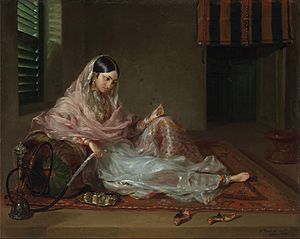
Dhaka became the capital of the Mughal province of Bengal, Bihar, and Orissa in 1610. This large province included modern-day Bangladesh and parts of eastern India. The city was founded during the rule of Emperor Jahangir. Dhaka became one of the richest cities in the world during this time. Its wealth grew even more under Governor Shaista Khan (1644-1677 and 1680–1688).
Bengal was a major economic hub for the Mughal Empire. Dhaka was the center of the muslin trade in Bengal, and its fine muslin fabric was famous even in distant places like Central Asia. The region also had a large shipbuilding industry. The Mughals built beautiful gardens, tombs, mosques, and forts in the city. Important buildings like the Bara Katra and Choto Katra were built as inns for travelers. The Bara Katra also served as a home for Mughal governors.
Islam Khan I was the first Mughal governor to live in Dhaka. He named it "Jahangir Nagar" (The City of Jahangir). The city grew a lot under Governor Shaista Khan, becoming home to nearly one million people. Construction of the Lalbagh Fort began in 1678 by Prince Azam Shah, a son of Emperor Aurangzeb. However, the fort was never finished after the prince's sister, Pari Bibi, passed away. In 1717, Dhaka lost its status as the main capital when the provincial capital moved to Murshidabad.
British Rule
Under the Nawabs of Bengal, a deputy governor called the Naib Nazim of Dhaka managed the city. European trading companies also set up their businesses here. After the Battle of Buxar in 1765, the British East India Company took control of tax collection. By 1793, the British East India Company fully controlled Dhaka.
At first, the British did not focus on developing Dhaka. The local textile industry suffered because of high taxes and cheap British goods. The nearby city of Calcutta grew rapidly, which also affected Dhaka. In 1824, Dhaka was described as a "city of magnificent ruins."
Trade and People

Dhaka had factories belonging to the English, Dutch, and French East India Companies. Many different groups of people came to live in Dhaka during the Mughal Empire, including Armenians, Marwaris (a Hindu trading community), Jews, and Greeks. These communities helped with trade and social life. Today, some neighborhoods in Old Dhaka still have names that reflect these communities, like Farashganj (French Bazaar) and Armanitola (Armenian Quarter).
The city's surrounding areas provided goods like rice, jute, silk, and cotton. International trade brought wealth to many families in Dhaka.
British Raj Period
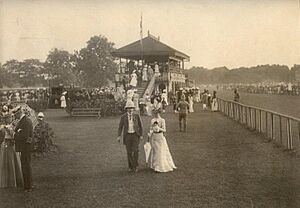
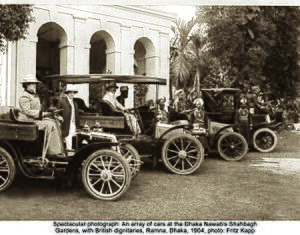
After the Indian mutiny of 1857, the British government took direct control. They established the Dhaka Cantonment for their army. The British developed modern areas around Ramna and Shahbag Garden. Public transport, like hansom cabs, appeared in 1856. A modern water system was introduced in 1874, and railways began operating in 1885. The first films were shown in 1898, and electricity arrived in 1901.
Important educational institutions like Dhaka College and Eden College were built during this time. Horse racing was a popular sport. Cars started appearing after 1900.
Dhaka's importance grew again in the early 1900s with the first partition of Bengal in 1905. The city became the capital of Eastern Bengal and Assam, a large province. This led to the construction of grand buildings like the High Court and Curzon Hall. In 1906, the All India Muslim League was founded in Dhaka. The partition was later cancelled in 1911.
As a "compensation" for the cancellation, the University of Dhaka was established in 1921. It was modeled after the University of Oxford and became known as the Oxford of the East. Famous scientists and writers taught there. The first silent films were also made in Dhaka during the 1920s.
Modern Dhaka
Dhaka grew rapidly after the partition of India in 1947. It became the "second capital" of Pakistan and then the legislative capital in 1962. New neighborhoods like Dhanmondi and Gulshan were developed. Living standards improved, and the economy became more industrial. The world's largest jute mill was built nearby.
The Dhaka Stock Exchange opened in 1954. The Dhaka Improvement Trust was set up in 1956 to plan the city's growth. The Bengali Language Movement in the early 1950s was a key moment for the city. In 1971, after a period of unrest, Dhaka became the capital of independent Bangladesh following the Liberation War.
Since independence, Dhaka's population has grown from hundreds of thousands to millions. This growth is largely due to people moving from rural areas. The city has seen new buildings like the National Parliament House and a new international airport. Dhaka also hosted the first summit of the South Asian Association for Regional Cooperation (SAARC) in 1985.
In recent decades, Dhaka has experienced strong economic growth. However, it faces challenges like traffic jams and a large number of people living in slums. The Dhaka Metro Rail opened its first phase in 2022 to help with transport.
City Layout
Dhaka is located in central Bangladesh on the eastern banks of the Buriganga River. The city is flat and close to sea level, which makes it prone to flooding during the monsoon season. Dhaka District is surrounded by other districts like Gazipur and Narayanganj.
City View
Most of Dhaka's growth has been unplanned, especially in the northern areas and city center. Many buildings are concrete high-rise buildings. While Old Dhaka is a historic market area, newer developments are mostly in the north.
Dhaka doesn't have one main business district. Old Dhaka is the historic commercial heart. Areas like Motijheel and Gulshan have become important business centers. Many government buildings are found in Motijheel and Sher-e-Bangla Nagar.
The city has many large roads, but traffic rules are often not followed. Street vendors and beggars are common. In recent years, many shopping malls have been built, including Jamuna Future Park and Bashundhara City, which are among the largest in South Asia.
Weather
Dhaka has a tropical savanna climate, meaning it has a distinct rainy season. The average yearly temperature is about 26°C (79°F). Most of the rain falls between May and October.
| Climate data for Dhaka (1991–2020) | |||||||||||||
|---|---|---|---|---|---|---|---|---|---|---|---|---|---|
| Month | Jan | Feb | Mar | Apr | May | Jun | Jul | Aug | Sep | Oct | Nov | Dec | Year |
| Record high °C (°F) | 31.3 (88.3) |
35.9 (96.6) |
40.6 (105.1) |
42.3 (108.1) |
41.1 (106.0) |
38.7 (101.7) |
38.0 (100.4) |
37.5 (99.5) |
37.8 (100.0) |
37.4 (99.3) |
34.5 (94.1) |
33.0 (91.4) |
42.3 (108.1) |
| Mean daily maximum °C (°F) | 24.6 (76.3) |
28.3 (82.9) |
32.4 (90.3) |
33.9 (93.0) |
33.6 (92.5) |
32.8 (91.0) |
32.1 (89.8) |
32.3 (90.1) |
32.4 (90.3) |
31.9 (89.4) |
29.7 (85.5) |
26.1 (79.0) |
30.8 (87.4) |
| Daily mean °C (°F) | 18.4 (65.1) |
22.1 (71.8) |
26.4 (79.5) |
28.6 (83.5) |
28.9 (84.0) |
29.1 (84.4) |
28.9 (84.0) |
29.0 (84.2) |
28.7 (83.7) |
27.5 (81.5) |
24.0 (75.2) |
19.9 (67.8) |
26.0 (78.8) |
| Mean daily minimum °C (°F) | 13.3 (55.9) |
16.6 (61.9) |
21.1 (70.0) |
24.0 (75.2) |
24.9 (76.8) |
26.3 (79.3) |
26.4 (79.5) |
26.5 (79.7) |
26.0 (78.8) |
24.1 (75.4) |
19.5 (67.1) |
15.2 (59.4) |
22.0 (71.6) |
| Record low °C (°F) | 5.6 (42.1) |
6.7 (44.1) |
10.6 (51.1) |
16.6 (61.9) |
17.9 (64.2) |
21.5 (70.7) |
21.1 (70.0) |
21.7 (71.1) |
21.1 (70.0) |
17.2 (63.0) |
10.6 (51.1) |
7.2 (45.0) |
5.6 (42.1) |
| Average precipitation mm (inches) | 7 (0.3) |
21 (0.8) |
48 (1.9) |
128 (5.0) |
272 (10.7) |
317 (12.5) |
391 (15.4) |
315 (12.4) |
285 (11.2) |
174 (6.9) |
21 (0.8) |
11 (0.4) |
1,990 (78.3) |
| Average precipitation days (≥ 1 mm) | 1 | 2 | 4 | 8 | 14 | 17 | 21 | 21 | 17 | 10 | 2 | 1 | 118 |
| Average relative humidity (%) | 71 | 64 | 62 | 71 | 76 | 82 | 83 | 82 | 83 | 78 | 73 | 73 | 75 |
| Mean monthly sunshine hours | 190.9 | 207.0 | 237.3 | 223.8 | 206.9 | 145.2 | 140.4 | 143.9 | 142.6 | 192.2 | 206.5 | 186.9 | 2,223.6 |
| Source 1: NOAA | |||||||||||||
| Source 2: Bangladesh Meteorological Department (humidity 1981–2010), Sistema de Clasificación Bioclimática Mundial (extremes 1934–1994) | |||||||||||||
Green Spaces
Dhaka has several parks and green areas, including Ramna Park, Suhrawardy Udyan, and the National Botanical Garden.
Rivers and Lakes
About 10% of Dhaka's area is covered by water, with many ponds and canals. The Buriganga River flows past the city and is one of the most polluted rivers in Bangladesh. Dhaka is surrounded by six interconnected river systems that help with trade, transport, and draining stormwater. The city also has several lakes, such as Crescent Lake and Hatirjheel-Begunbari Lake.
Environmental Challenges
Air and water pollution are big problems in Dhaka. Vehicle traffic and factories cause air pollution. Water pollution comes from untreated wastewater from homes and industries. Only a small part of the city is connected to a proper sewer system. This means rivers around Dhaka are very polluted and not safe for human use.
Water bodies and wetlands are also being filled in for new buildings, which harms the natural environment and wildlife.
Economy and Business
The Greater Dhaka Area is a major economic hub, making up 35% of Bangladesh's economy. Dhaka is considered a "beta− global city" because it helps connect its region to the world economy. Important industrial areas include Tejgaon and Shyampur. The city has a growing middle class that buys many modern goods. Shopping malls are also very important to the economy.
Many people in Dhaka work as hawkers, street vendors, or rickshaw drivers. There are about 400,000 rickshaw drivers alone. A large part of the workforce is in household or informal jobs. About 800,000 people work in the textile industry.
Almost all big local companies have their main offices in Dhaka. Famous organizations like Grameen Bank and BRAC, which help people with small loans and development, are based here. The city has seen a huge construction boom with many new high-rise buildings. Business has grown especially in finance, banking, manufacturing, and telecommunications.
Business Centers
Dhaka has several important business districts.
- The riverfront of Old Dhaka has many small businesses and factories.
- Motijheel is the largest business district in Bangladesh, home to the central bank and major state-owned banks.
- In the north, areas like Gulshan, Banani, and Uttara have become major business centers with many international companies.
- The Purbachal New Town Project is planned to be a future business hub.
Stock Market
The Dhaka Stock Exchange (DSE) is an important part of Bangladesh's economy. Many large companies are listed there, including:
- Grameenphone
- BEXIMCO
- Square Pharmaceuticals
People of Dhaka
| Historical population | ||
|---|---|---|
| Year | Pop. | ±% |
| 1951 | 335,760 | — |
| 1961 | 507,921 | +51.3% |
| 1971 | 1,373,718 | +170.5% |
| 1981 | 3,265,663 | +137.7% |
| 1991 | 6,620,697 | +102.7% |
| 2001 | 10,284,947 | +55.3% |
| 2011 | 14,730,537 | +43.2% |
| 2022 | 22,478,116 | +52.6% |
| for Dhaka Agglomeration: | ||
Population Growth
Dhaka and its surrounding areas are home to over 22 million people as of 2022. The population is growing very quickly, one of the fastest rates in Asia. This growth is mostly because people are moving from rural areas to the city. This rapid growth makes it hard for the city government to provide enough services like water, electricity, and waste management.
Slums
About 30% of Dhaka's population lives in slums, which are unplanned settlements. These are often new arrivals from rural areas. People in slums often have limited access to clean water, sanitation, and other basic services. The largest slum is in Kamrangirchar, where about 600,000 people live.
Diverse Communities
People from almost every region of Bangladesh live in Dhaka. The original residents of the old city are called Dhakaiya and have their own unique Bengali dialect and culture. Dhaka is also home to many Bihari refugees, who are descendants of Muslims who moved from India in 1947. There are also smaller groups of Rohingya, Santal, and other tribal peoples.
Languages Spoken
Most people in Dhaka speak Bengali, which is the national language. Many different Bengali dialects are also spoken. English is widely used, especially for business. Some non-Bengali communities, like the Biharis, speak Urdu.
Education Levels
The number of people who can read and write (literacy rate) in Dhaka is increasing fast. It was 69.2% in 2001 and went up to 74.6% by 2011, which is higher than the national average.
Religions
| Religion in Dhaka City (2011) | ||||
|---|---|---|---|---|
| Religion | Percent | |||
| Islam | 95.72% | |||
| Hinduism | 3.60% | |||
| Christianity | 0.55% | |||
| Other or not stated | 0.13% | |||
Islam is the main religion in Dhaka, with most people being Muslim. Hinduism is the second-largest religion. Smaller groups practice Christianity and Buddhism.
Culture and Traditions
Stories and Books
Dhaka is a big center for Bengali literature. It has been important for Bengali Muslim writers for over a century. It also has old traditions of Urdu and Persian literature. Many books are set in Dhaka, showing its history and daily life.
Famous Fabrics

For hundreds of years, the Dhaka region has been known for making fine cotton fabrics like Muslin. Weavers in Dhaka were supported by rulers and supplied textiles to royal courts. Dhaka became a very important center for the cotton textile trade. UNESCO has recognized Jamdani muslin as a special cultural heritage. It is a beautiful, patterned cotton fabric woven by hand, and it is a symbol of identity and pride for the weavers.
Celebrations and Festivals
Dhaka celebrates many national holidays like Language Martyrs' Day (February 21), Independence Day (March 26), and Victory Day (December 16). People gather at places like the Shaheed Minar to remember national heroes. Schools and colleges hold fairs and concerts.
Pohela Baishakh, the Bengali New Year (April 14), is celebrated with large crowds in areas like Shahbag and Ramna Park. Pahela Falgun, the first day of spring, is also celebrated with colorful events, where women often wear yellow saris. The Ekushey Book Fair takes place every February, dedicated to those who fought for Bengali to be a state language. The Shakrain Festival, with kite flying, is an annual event in Old Dhaka.
Islamic festivals like Eid ul-Fitr and Eid ul-Adha, the Hindu festival of Durga Puja, the Buddhist festival of Buddha Purnima, and Christmas are all celebrated widely in the city.
Traditional folk music is very popular, as are the works of national poet Kazi Nazrul Islam and national anthem writer Rabindranath Tagore.
Rickshaws and Art
Rickshaws are a famous symbol of Dhaka. They are brightly painted with flowers, birds, and scenes from movies or history. This rickshaw art is considered a key part of the city's culture and a lively form of folk art by UNESCO.
Delicious Food
Dhaka has a rich history of Muslim cuisine, especially Mughlai cuisine. Restaurants serve many types of biryani, like Kachi Biryani (with goat meat) and Tehari (with beef). Khichuri rice is a popular comfort food. A special kind of Bengali-Mughlai food developed here. The Kachi Biryani, with mutton and potatoes, is very famous. Borhani is a drink often served with biryani. Bakarkhani breads from Dhaka were even served in Mughal courts.
Haji biryani has been a leading biryani restaurant since 1939. Local kebabs, like seekh kebab and chicken tikka, are also very popular. Different kinds of bhurta (mashed vegetables) and Bengali fish curries are common. Dhaka also has many Western and Chinese restaurants, as well as Thai, Japanese, Korean, and Italian food in fancier areas.
During Ramadan, Chowkbazaar becomes a busy market for iftar items (food to break the fast). The jilapi of Dhaka are thicker than those in other places. Street foods like phuchka and jhalmuri are also very popular.
City Buildings
Dhaka's buildings show its history from Mughal, British, and modern times. The oldest brick building is the Binat Bibi Mosque, built in 1454. Old Dhaka has over 2000 historic buildings from the 16th to 19th centuries. Modern Dhaka is sometimes called a "concrete jungle" because of its many new buildings.
In the old city, you can still see old inns like Bara Katra and Choto Katra. The Curzon Hall is a famous British colonial building. Among modern buildings, the National Parliament House, designed by Louis I. Kahn, is a very important civic space. The Kamalapur railway station is another famous modern building. City Centre Bangladesh is currently the tallest building in the city.
Books and News
Dhaka is the center for media in Bangladesh. It has state-owned TV and radio stations, as well as many private ones. There are over two dozen Bengali TV channels and many radio stations. Dhaka is home to national newspapers in both Bengali and English, like Prothom Alo and The Daily Star.
Learning and Research
Dhaka has the most schools, colleges, and universities of any city in Bangladesh. The education system has five levels: primary, junior, secondary, higher secondary, and university. Education is mainly in Bengali, but English is also widely taught. Many Muslim families also send their children for religious education.
There are 52 universities in Dhaka. Dhaka College, founded in 1841, is the oldest higher education institution. The University of Dhaka, established in 1921, is the oldest public university in the country, with many students and teachers. Other important universities include Bangladesh University of Engineering and Technology (BUET) and Bangabandhu Sheikh Mujib Medical University (BSMMU). Dhaka Medical College is one of the oldest and largest medical colleges.
Two Nobel laureates are connected to Dhaka: Amartya Sen, who grew up here, and Muhammad Yunus, who studied at Dhaka University and founded the Grameen Bank.
Research Groups
Dhaka is home to many important learned societies and think tanks that do research and promote knowledge. These include:
- Asiatic Society of Bangladesh
- Bangla Academy
- Bangladesh Academy of Sciences
- International Centre for Diarrhoeal Disease Research, Bangladesh
- Yunus Centre
Sports in Dhaka

Cricket and football are the most popular sports in Dhaka and Bangladesh. Many schools, colleges, and private groups have teams that compete in city and national events. The Dhaka Metropolis cricket team represents Dhaka in the national cricket league.
Dhaka hosted the first official Test cricket match for the Pakistan cricket team in 1954. The Bangabandhu National Stadium used to be the main place for cricket but now only hosts football. It hosted the opening ceremony of the 2011 Cricket World Cup. The Sher-e-Bangla National Cricket Stadium is now used only for cricket and hosted several matches of that tournament. Dhaka has also hosted the South Asian Games three times.
In football, the Dhaka Derby between Mohammedan SC and Abahani Limited Dhaka is the biggest sports rivalry. The Bangabandhu National Stadium is the home for the national football team.
The National Sports Council, which promotes sports, is based in Dhaka. The city also has other stadiums for local events. There are two golf courses in Dhaka: Army Golf Club and Kurmitola Golf Club.
City Services
Getting Around
Dhaka is one of the world's least motorized cities. The three-wheeled cycle rickshaw is the most common way to get around, making up more than half of all trips in 2011. Dhaka has a lot of traffic jams, which cost the local economy billions of dollars each year. The average speed of a car in the city is very slow. Auto rickshaws powered by natural gas, called "CNGs," are also popular.
Roads
Dhaka is connected to other parts of Bangladesh by highways and railways. Five of Bangladesh's main national highways start from Dhaka. There are also bus services to cities in India.
The Dhaka Elevated Expressway is the first of its kind in the country, helping to connect different parts of the city.
Rickshaws
Cycle rickshaws and CNG auto-rickshaws are the main ways to travel within the city. Over 1.5 million rickshaws operate daily, making it the highest number in any city worldwide.
Ride Sharing
Since 2016, Uber and Pathao have become popular for ride-sharing in Dhaka, offering both car and motorcycle services.
Buses
Buses carry millions of passengers every day. Most public buses are run by private companies, with some by the state-owned Bangladesh Road Transport Corporation (BRTC). There are three main bus terminals for travel to other cities. A new Bus Rapid Transit system is expected to open soon, which will greatly reduce travel time to nearby areas.
Water Transport
The Sadarghat River Port on the Buriganga River is used for transporting goods and passengers by boat to other parts of Bangladesh. Water bus services are also available on the Buriganga River and some lakes.
Trains
Kamalapur railway station is the city's largest and busiest train station. The state-owned Bangladesh Railway provides train services to other major cities in Bangladesh. The Maitree Express and Mitali Express connect Dhaka to West Bengal in India.
The Dhaka Metro Rail is a new rapid transit system. The first part of it opened in December 2022. This metro system is part of a plan to improve transport in Dhaka. Before the metro, Dhaka was the largest city in the world without such a system.
Air Travel
Hazrat Shahjalal International Airport is the largest and busiest international airport in Bangladesh. It is located north of the city center. It handles millions of passengers each year and is the main hub for most Bangladeshi airlines. The airport connects Dhaka to major cities in Asia, Europe, and the Middle East. A new, larger terminal is expected to open in 2024.
Water and Waste Services
Managing water in Dhaka has many challenges, including flooding, poor service, and polluted river water. The Dhaka Water Supply and Sewerage Authority (Dhaka WASA) is in charge of providing drinking water, sewerage, and stormwater drainage.
The sewage system is not good enough, with most wastewater going directly into rivers without treatment. This causes severe pollution. While there are two sewage treatment plants, they cannot handle all of the city's waste. Dhaka WASA plans to build more plants to treat all sewage by 2030.
Most of the city's water comes from underground, because the rivers are too polluted to use easily. This means the underground water levels are dropping. In slum areas, many households share water connections and have limited access to proper toilets.
Sister Cities
Dhaka has friendly connections with these cities around the world:
See also
 In Spanish: Daca para niños
In Spanish: Daca para niños







